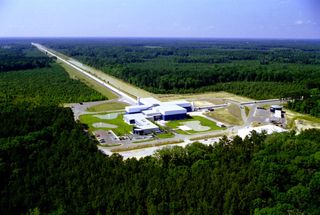
Seven years ago, researchers with the Laser Interferometer Gravitational-Wave Observatory (LIGO) reported the first detection of gravitational waves. Now, the list of gravitational wave candidates numbers nearly 100.
And astronomers are confident they can find more of these ripples in the fabric of space-time, which are caused by the acceleration of massive objects — for example, two black holes spiraling toward each other for a cataclysmic merger.
May 24 marked the start of Observation Run 4 (O4), the newest effort of the LIGO-Virgo-KAGRA (LVK) Collaboration. With newly upgraded gravitational wave detectors, astronomers hope O4 can make seeing gravitational waves — and the objects that produce them — an everyday occurrence.
Related: Hunting gravitational waves: The LIGO laser interferometer project in photos
"We expect to go from what we had in our previous run — one neutron star every couple of months, one [binary] black hole every week or 10 days," said Salvatore Vitale, an astrophysicist at the Massachusetts Institute of Technology (MIT), "to getting a binary black hole every day or two, getting a neutron star every week."
Gravitational waves are a byproduct of general relativity, as envisioned by Albert Einstein a century ago. General relativity holds that space and time are like a fabric. Every object leaves a dent in that fabric, which we perceive as gravity. In that world, disturbances — such as two black holes colliding — can send ripples across the fabric. Astronomers can use laser-based detectors spot those ripples.
As LVK's name suggests, the collaboration is a multi-pronged effort, combining four detectors on three continents: LIGO's two detectors, one in Livingston, Louisiana and another in Hanford, Washington; Virgo in Europe, stretching across the Tuscan plains southeast of Pisa, Italy; and KAGRA, under the mountains of central Japan.
Get the Space.com Newsletter
Breaking space news, the latest updates on rocket launches, skywatching events and more!
Alas, as O4 begins, only LIGO's pair is fully operational. Virgo must undergo repairs to a damaged mirror and will remain deactivated for an uncertain amount of time. KAGRA, meanwhile, will observe for just a month before going offline again; it hasn't reached its target sensitivity, and its operators hope to restart it again in late 2024.
Astronomers want more detectors because a single gravitational wave detector doesn't provide details about the direction in which the waves are traveling. So, they need multiple detectors to actually triangulate the source of gravitational waves. With all four, astronomers could trace a source to just a few square degrees of sky. With just two detectors, they're stuck with a far larger wedge of the sky.
"It's going to be harder for us to tell our friends with telescopes where to point their telescope," said Vitale.
But even two detectors might reap a bounty of science. With upgraded sensitivity, the detectors can pick out weaker or more distant gravitational waves. That means scientists can pick up more events.
And with more events, they hope to begin answering a looming question: Where did the black holes they're seeing tend to form?
Perhaps black holes formed inside galaxies; perhaps they formed outside, in globular clusters or in dwarf galaxies. Or, perhaps, they're primordial, having formed in raw space at the beginning of the universe.
"To answer this question, you need to have a large dataset," said Vitale.
LVK's current schedule calls for O4 to run for 18 months, into 2025. Afterward, the gravitational wave detectors will shut down for upgrades and engineering work — and start back up again around 2027 for a fifth, longer observing run.
Join our Space Forums to keep talking space on the latest missions, night sky and more! And if you have a news tip, correction or comment, let us know at: community@space.com.

Rahul Rao is a graduate of New York University's SHERP and a freelance science writer, regularly covering physics, space, and infrastructure. His work has appeared in Gizmodo, Popular Science, Inverse, IEEE Spectrum, and Continuum. He enjoys riding trains for fun, and he has seen every surviving episode of Doctor Who. He holds a masters degree in science writing from New York University's Science, Health and Environmental Reporting Program (SHERP) and earned a bachelors degree from Vanderbilt University, where he studied English and physics.
